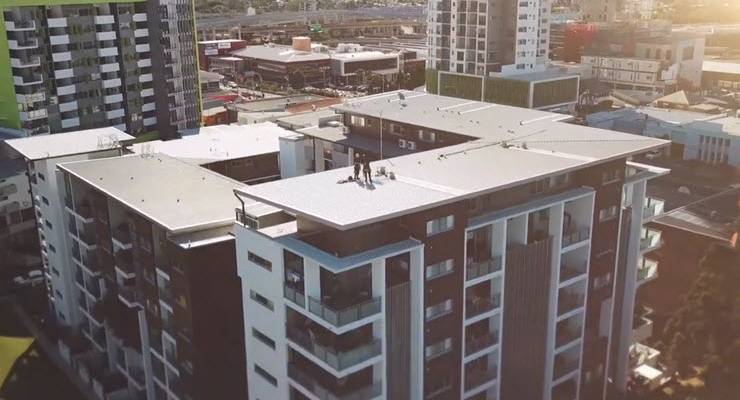
The Richmond Apartments — 107 homes built over eight storeys clustered around an atrium and with cascading plants — sits in Bowen Hills, a few kilometres from Brisbane.
It was developed by the not-for-profit Brisbane Housing Company when many residents would struggle to afford a decent home in the private rental market.
Adrian, 69, said he would have to pay $100-$150 more a week to a private landlord. Erica said that she used to have to cook her meals in an electric frypan in a cramped bedsit with no kitchen. Now she not only has a stove, an oven and a separate bedroom, but a balcony, and as the building was designed for the climate, she stays comfortable in a Brisbane summer without needing an air-conditioner.
National shortfall of low-income rentals
Research shows there is a nationwide shortfall of 433,000 affordable homes for renters on the lowest incomes. Yet Richmond shows what’s possible when three tiers of government work together.
The building was supported by Brisbane City Council, and the Queensland government tipped in $1 million, but the core investment of more than $9 million came from a federal stimulus package in response to the global financial crisis.
Unlike pink batts and school halls, social housing initiatives during the GFC got little fanfare — their success made them uncontroversial.
An investment of $5.6 billion enabled almost 20,000 homes to be built. Another 12,000 were repaired. According to KPMG the scheme created 14,000 jobs and every federal dollar invested generated $1.30 in economic activity.
But remarkably the stimulus that made Richmond Apartments possible is the only significant federal government investment in building homes for low-income renters in the past quarter century.
Construction employs one in 10 workers
Construction employs almost one in 10 workers but the Housing Industry Association predicts that in this financial year new starts in multi-unit dwellings will fall by 37% in New South Wales and by 42% in Victoria, on top of falls of 28% and 22% in the previous 12 months.
In its submission ahead of the October 6 budget, Master Builders Australia forecasts that nationally new housing starts will be down 27% this financial year, after a 13% fall last year.
Consulting company McKinsey estimates the construction sector had shed 46,000 jobs between the start of the pandemic and the end of June. It anticipates total job losses could hit 205,000 by March.
The government’s HomeBuilder program barely touches the sides of this problem — and there are fears jobs lost now could be jobs lost forever. History shows that many who lose employment in a downturn never work again.
Reserve Bank governor Philip Lowe said recently that “a long spell of unemployment” has “permanent effects” on people and “damages the fabric of our society”. Borrowing against future income was “entirely manageable and affordable” and “the right thing to do in the national interest”.
In a survey of Australia’s top economists, most agreed that the federal government should keep spending even if that required a substantial increase in debt.
Time to get SHARP
The GFC stimulus package that funded the development of Richmond Apartments provides a model response for the current crisis. There is already a detailed proposal on the table. SHARP — the Social Housing Acceleration and Renovation Program — proposes a $7.7 billion investment to build 30,000 homes and repair thousands more.
Modelling by SGS Economics and Planning estimates that SHARP would support the equivalent of up to 18,000 full-time jobs a year for four years and raise economic output by at least $15.7 billion.
So far the response from Canberra has been to say that housing is a state responsibility. This is a narrow reading of the constitution, which assumes that any powers not specifically vested in the Commonwealth remain with the states.
Yet the HomeBuilder program suggests the division of responsibility is not so clear-cut. The states also have no influence on some of the powerful drivers of the housing market and housing affordability for low-income renters — immigration, tax concessions, rent assistance and pension rates.
Most importantly, the states simply lack the revenue-raising powers to go it alone with the level of investment required.
As we mark the 75th anniversary of the end of World War II, the pandemic calls for a level of nation building ambition similar to 1945 — when the urgent need to build housing as part of post-war reconstruction forged the first 10-year Commonwealth-state housing agreement.
In the subsequent decades housing policy involved similar agreements, with the federal government funding the states to build social housing. Over the past 25 years we have dropped the ball. Now is the time to pick it up again.
Peter Mares is lead moderator at Cranlana Centre for Ethical Leadership at Monash University and the author of No Place Like Home: Repairing Australia’s Housing Crisis.








It will be a monumental change of focus if the Coalition can bring itself to embark on such a humane course….not hopeful.
For months commenters here, large charities and some parts of the media have been calling for social housing, not just because Australia is desperately short of low cost housing, but because it difficult to imagine a more effective stimulatory project. It all seems to fall on deaf ears, neither party has shown any interest in it. But if spread through towns all over the country countless ongoing jobs would be created. And here’s what makes it a no brainer, unlike almost any other stimulatory package the billions spent will actually be repaid. How good is that!
Aye, there’s the rub – “…neither party has shown any interest…”. To sleep, per chance to dream of a workers’ party.
Funny that, almost as if “Labor” had some other agenda or overriding interest… overstretched negative geared tradies?
According to figures last year Australia had about 4% social housing. This is half the average for countries with similar economic circumstances. Providing more social housing is not just a good economic move, its a moral imperative.